Mitali Perkins's Blog, page 37
October 22, 2010
Poetry Friday: In Which I Ask Poet Mary Oliver My Pressing Question
"How can a poet serve the poor and powerless?" I asked.
"Man does not live by bread alone," answered Mary Oliver , one of my favorite living poets. She hesitated, then: "These days, different voices are speaking of their own cultures in poetry, and comfort is given by listening to them."
Lest you think we were having coffee somewhere on the Cape, just the two of us, let me set the scene: a packed chapel on the Wellesley campus, stuffed with Oliver fans (who tend to be mainly white, silver-haired, upper-middle-class women).
After reading a few of her poems, Ms. Oliver was taking a few questions written on cards by members of the audience. Mine was one, and I'm grateful it was presented because it's one of my struggles as a writer—the time taken in solitude, crafting words and stories, is time that could be given in service to the poor or spent fighting for justice.
Any answers or thoughts from my fire escape visitors? As you mull over the question, here are some other quotes from Mary Oliver, scribbled in my journal at the event:





"Man does not live by bread alone," answered Mary Oliver , one of my favorite living poets. She hesitated, then: "These days, different voices are speaking of their own cultures in poetry, and comfort is given by listening to them."
Lest you think we were having coffee somewhere on the Cape, just the two of us, let me set the scene: a packed chapel on the Wellesley campus, stuffed with Oliver fans (who tend to be mainly white, silver-haired, upper-middle-class women).
After reading a few of her poems, Ms. Oliver was taking a few questions written on cards by members of the audience. Mine was one, and I'm grateful it was presented because it's one of my struggles as a writer—the time taken in solitude, crafting words and stories, is time that could be given in service to the poor or spent fighting for justice.
Any answers or thoughts from my fire escape visitors? As you mull over the question, here are some other quotes from Mary Oliver, scribbled in my journal at the event:
Flipping through a stack of books to find a poem: "I should have one of those iPads—I've seen them."Come visit me on the Fire Escape!
On disciplined appointments of writing: "If you're having a romance with someone and don't show up ..."
Q. What is your place in the world? "A beast given the gift of imagination."
Q. What do you do when you cannot write? "Walk."
Q. What's your favorite word? "Adjectives are worth nickels. Verbs are worth fifty cents."
Telling a story about Flaubert and work, who skipped a weekend of play with his friends to write: "'Was it worth it?' his friends asked upon returning. 'Oh, yes,' answered Flaubert. 'On Saturday I took out a semi-colon. And on Sunday, I put it back.'"




Published on October 22, 2010 10:33
October 19, 2010
JIMI: SOUNDS LIKE A RAINBOW | A Visit From Gary Golio
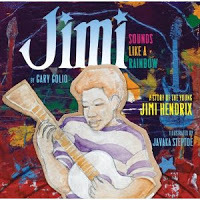 With sounds and colors that explode off the page, JIMI: SOUNDS LIKE A RAINBOW (written by Gary Golio and illustrated by Javaka Steptoe), is a glorious tribute to Seattle's multicultural creativity and the genius of Jimi Hendrix.
With sounds and colors that explode off the page, JIMI: SOUNDS LIKE A RAINBOW (written by Gary Golio and illustrated by Javaka Steptoe), is a glorious tribute to Seattle's multicultural creativity and the genius of Jimi Hendrix.Kids and parents alike will be inspired by Hendrix's passion for music and art, and his single-minded vision to express that passion through the voice of an electric guitar. Golio's words sing and Steptoe's illustrations dance, making the reader want to put on some Hendrix (right now!) and whirl around the room.
Today, as part of his blog tour, I've invited Gary to share his thoughts about how race and racism affected Hendrix's music and music.
Jimi Hendrix: The Rainbow Vision
"An appreciation of pluralism nourishes attributes urgently needed in people today: psychological security, capacity for understanding, and appreciation of difference." (Elaine Pinderhughes, Understanding Race, Ethnicity, and Power)
 In many ways, Jimi Hendrix' life was spent seeking and promoting wholeness or healing, and much of his creative work can be looked at through that lens. Multicolored in his racial heritage (a mix of African, European, and Cherokee ancestry), he grew up in Seattle at a time—the 1950s—when it was proudly called the Rainbow City. Jimi went to school with Asians (Chinese, Japanese, Filippinos), Hispanics (South Americans, Mexicans), African-Americans, whites, and American Indians—people of all colors, who co-existed in relative harmony. Jimi even lived for a time at Seattle's Yesler Terrace, one of the first integrated public housing projects in the U.S.
In many ways, Jimi Hendrix' life was spent seeking and promoting wholeness or healing, and much of his creative work can be looked at through that lens. Multicolored in his racial heritage (a mix of African, European, and Cherokee ancestry), he grew up in Seattle at a time—the 1950s—when it was proudly called the Rainbow City. Jimi went to school with Asians (Chinese, Japanese, Filippinos), Hispanics (South Americans, Mexicans), African-Americans, whites, and American Indians—people of all colors, who co-existed in relative harmony. Jimi even lived for a time at Seattle's Yesler Terrace, one of the first integrated public housing projects in the U.S.While he could listen to black radio stations (with music by black musicians) beginning only in 1958, Jimi had seen Elvis—the great White Wonder who fearlessly did his take on what was still considered Race music (gospel, jazz, blues)—in September of 1957, when he was 14, at a Seattle stadium. Before that, from the time he was very young, Jimi heard a wide variety of genres played (on record) and sung by his father right at home. As a teenager, he listened to Dean Martin and Frank Sinatra alongside Howlin' Wolf, Lightnin' Hopkins, B.B. King, and Chuck Berry. He had a place in his heart and mind for rock 'n' roll, the blues, jazz, pop, and gospel, and would later add Indian ragas, Flamenco guitar, Bach, and Handel to that heady mix. He even speculated about what "the blues scene" would be like on other planets, thoughts that arose from his love of science fiction and musings on extra-terrestrial life and intelligence.
In 1966—a year before he was "discovered"—Jimi walked through Harlem carrying his Dylan albums and singing Bob's praises, much to the bewilderment of the black community. When he arrived in London in September of that year, he dazzled young white English musicians in love with the blues (Cream, the Rolling Stones, the Who) not just with his virtuosic and authentic playing, but by being the first black musician (and man) most of these aficionados had ever met. In doing so, Jimi acted as much as an unofficial race diplomat as an ambassador of black music. When he formed the Jimi Hendrix Experience that same fall, he became the black leader of a band including two white musicians—something clearly ahead of its time.
All that said, Jimi experienced racism throughout his life. He heard the unsavory epithets as a child, and as an adult was first referred to by European critics as "the Black Elvis" and "the Wild Man of Borneo"—terms which, while strangely praiseworthy in their intent, were clearly hurtful in their reference to Jimi's "otherness" as a talented and feted noble savage. Still, he filled his songs early on with hopeful themes of Jungian wholeness—waterfall sanctuaries of creativity (May This Be Love), joyful interstellar exploration (Third Stone From The Sun), spiritual unity and togetherness (Are You Experienced?, One Rainy Wish)—while openly sharing with us his fears of psychic fragmentation (I Don't Live Today, Love or Confusion, Castles Made of Sand).
A very human being, Jimi Hendrix allowed painful as well as positive childhood experiences (poverty, multicultural inclusion, racism, exposure to the arts) to shape his optimistic, almost visionary approach to racial pluralism. He welcomed diversity in people and culture as much as in music, and believed that the art he offered—what he referred to as "electric church"—reflected a belief in tolerance strengthened by his friendship with Martin Luther King Jr. Surprising as it may seem, for those willing to open their ears and hearts, Jimi Hendrix may yet prove to be a powerful and positive role model for 21st-century children.
If you can just get your mind together Then come on across to me We'll hold hands and then we'll watch the sunrise From the bottom of the sea
Jimi Hendrix - Are You Experienced?
Thanks, Gary, for visiting us on the Fire Escape. May this beautiful book (which has already been starred by Kirkus and School Library Journal) inspire the next generation of diverse musicians, writers, and artists! Here's the schedule for the rest of Gary's blog tour:
Day 1 - Monday 10/18, Picture Book of the Day
Day 2 - Tuesday 10/19, Mitali's Fire Escape (here!)
Day 3 - Wednesday 10/20, The Brown Bookshelf
Day 4 - Thursday 10/21, Original Content
Day 5 - Friday 10/22, Tales from the Rushmore Kid
Day 6 - Monday 10/25, The Fourth Musketeer
Day 7 -Tuesday 10/26, Great Kid Books
An interview with Gary and Javaka will air on NPR's Weekend Edition in the coming weeks. Gary was also interviewed on WBZ, Boston's #1 station and is Author of the Month on Embracing the Child.
 Come visit me on the Fire Escape!
Come visit me on the Fire Escape!



Published on October 19, 2010 07:33
October 18, 2010
From Coast to Coast, I'm Talking Books
Last week I visited the Pleasanton Library
Bookleggers
in California (an amazing program where trained volunteers present books in the schools), co-presented to educators with author Jennifer Holm at
The Reading Bug Bookstore
in San Carlos, California, and addressed the topic of social justice in fiction to an engaged audience as part of a Boston Book Festival Panel. Here are some photos for your enjoyment:
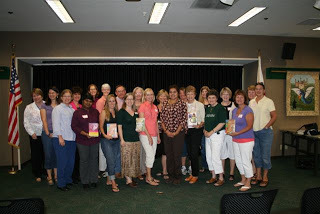
The Pleasanton Bookleggers. Find Mitali?
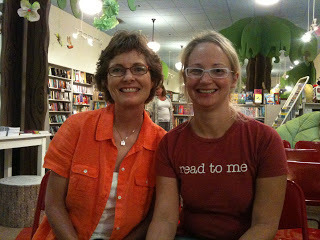
Twitter buddy Debbie Duncan, author and KQED reporter, and Jenni Holm (BABYMOUSE) at the Reading Bug Bookstore in San Carlos, California--a gorgeous place dedicated to Kid/YA books.
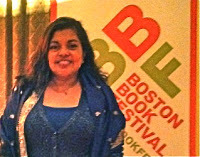
At the BBF Authors Dinner, hosted by the London Times Literary Supplement and the Hotel Commonwealth in Boston.

It's a blustery day, but the Boston Book Festival begins!
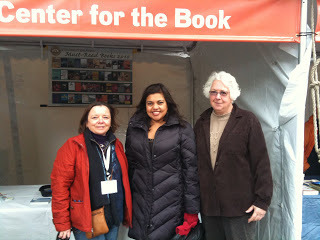
Visited the Massachusetts Center for the Book booth, where my Secret Keeper joined other books on a poster.
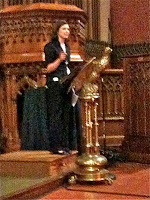
Boston Book Festival Executive Director Emily D'Amour Pardo introduces our panel on Social Justice in Fiction for Young Readers, held at the glorious Church of the Covenant in Boston.
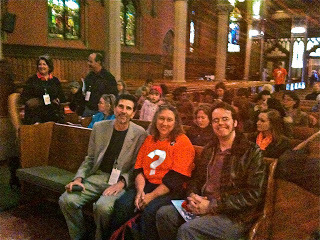
The crowd begins to gather behind fellow panelist Richard Michelson, our Panel organizer, Cambridge school librarian Karen Kosko, and friend and fellow writer John L. Bell.
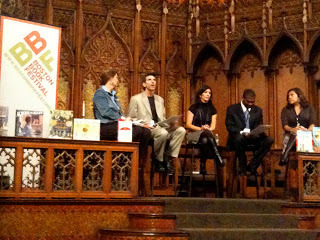
Richard presented the story behind Busing Brewster, his picture book set in 1970s Boston. Seated to his right is Katie Smith Milway, author of The Good Garden and the moderator of our panel.
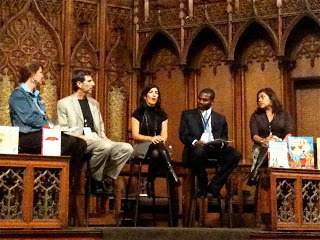
Christina Diaz Gonzalez talks about The Red Umbrella, her beautiful debut novel about Cuba's Operation Pedro Pan. Listening between us is Lionel Vital, who is featured in the picture book Selavi by Youme Landowne.
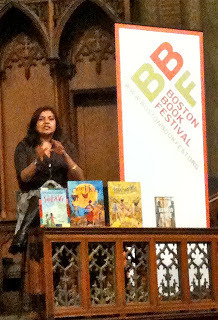
My turn!
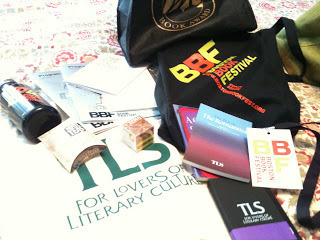
Lovely swag in our author gift bag from the Festival.
Come visit me on the Fire Escape!





The Pleasanton Bookleggers. Find Mitali?

Twitter buddy Debbie Duncan, author and KQED reporter, and Jenni Holm (BABYMOUSE) at the Reading Bug Bookstore in San Carlos, California--a gorgeous place dedicated to Kid/YA books.

At the BBF Authors Dinner, hosted by the London Times Literary Supplement and the Hotel Commonwealth in Boston.

It's a blustery day, but the Boston Book Festival begins!

Visited the Massachusetts Center for the Book booth, where my Secret Keeper joined other books on a poster.

Boston Book Festival Executive Director Emily D'Amour Pardo introduces our panel on Social Justice in Fiction for Young Readers, held at the glorious Church of the Covenant in Boston.

The crowd begins to gather behind fellow panelist Richard Michelson, our Panel organizer, Cambridge school librarian Karen Kosko, and friend and fellow writer John L. Bell.

Richard presented the story behind Busing Brewster, his picture book set in 1970s Boston. Seated to his right is Katie Smith Milway, author of The Good Garden and the moderator of our panel.

Christina Diaz Gonzalez talks about The Red Umbrella, her beautiful debut novel about Cuba's Operation Pedro Pan. Listening between us is Lionel Vital, who is featured in the picture book Selavi by Youme Landowne.

My turn!

Lovely swag in our author gift bag from the Festival.
Come visit me on the Fire Escape!




Published on October 18, 2010 08:50
October 15, 2010
Boston Book Festival 2010
 I'm honored to be part of this year's
Boston Book Festival
. I'll be chatting on a panel tomorrow called
Border Crossing: Social Justice in Fiction for Kids
. Here's the full
schedule
of events and the description of our session, taking place from 11:30 to 12:30 at the Church of the Covenant on 67 Newbury Street:
I'm honored to be part of this year's
Boston Book Festival
. I'll be chatting on a panel tomorrow called
Border Crossing: Social Justice in Fiction for Kids
. Here's the full
schedule
of events and the description of our session, taking place from 11:30 to 12:30 at the Church of the Covenant on 67 Newbury Street:Be transported to Burma, Cuba, Haiti and 1970s Boston and experience the challenges children just like you face every day. Mitali Perkins, author of Bamboo People, Christina Gonzalez, author of The Red Umbrella, Richard Michelson, author of Busing Brewster and Lionel Vital (inspiration for Youme Landowne's Selavi) tell the stories and struggles of children around the world. Hosted by Bridgespan's Katie Smith Milway, author of One Hen and The Good Garden.Come visit me on the Fire Escape!




Published on October 15, 2010 11:16
October 13, 2010
ONE MILLION MEN AND ME: A Visit From Kelly Starling Lyons
 Today I'm pleased to shut up and invite you to listen to
Kelly Starling Lyons
, author of ONE MILLION MEN AND ME. Kelly and I met at the
Multicultural Book Festival
in Washington D.C., an encouraging, enthralling experience for both of us.
Today I'm pleased to shut up and invite you to listen to
Kelly Starling Lyons
, author of ONE MILLION MEN AND ME. Kelly and I met at the
Multicultural Book Festival
in Washington D.C., an encouraging, enthralling experience for both of us.When I wrote One Million Men and Me (illustrated by Peter Ambush, published by Just Us Books), one of my dreams was to share it in Washington, D.C. I wanted to go back to the city where the Million Man March happened and celebrate the story with kids.
I got my chance the year it debuted. I was part of the Multicultural Children's Book Festival at the Kennedy Center. As I rode from the airport to the hotel, I thought back to that amazing event. I remembered walking through a sea of black men, seeing strangers embrace like brothers, watching people — young and old, rich and poor — praying and laughing together. I remembered a little girl I saw that day clutching her daddy's hand. Her eyes glistened and sparkled at the sight of men everywhere.
My desire to see the March through that sweet girl's eyes inspired my story. I named her Nia, because I felt she was there for a reason, just like me. Being in D.C. to share the book she, her father and a tapestry of men inspired was like coming full circle.At the Kennedy Center, a special energy flowed through the air. There was something magic about the idea of people from different backgrounds and cultures coming together to celebrate literature reflecting children of color. There with wonderful authors and illustrators like Mitali Perkins, Christopher Myers, Tonya Bolden, Lulu Delacre and more, I got ready to greet them. It wasn't long before I realized this would be different from anywhere else I had been.
As people came up to meet me and have their books signed, they brought their testimonies. Men smiled as they flipped through the pages and said it took them right back to that historic event. A father looked at the cover of One Million Men and Me with Nia on her dad's shoulders and remembered carrying his own daughter around the March that way. I met twin girls whose dad pushed them in a stroller around the March when they were 4-month-old infants. And women who proudly told me they took their sons to the March or cheered their husbands as they went.
For these people, One Million Men and Me was a touchstone and a reminder of what that day meant. I felt so honored that the book brought a piece of the March to life. But one of my most special moments came from two boys who never heard of the March. They had each won gift certificates from school for earning good grades and had enough money to buy a couple of books each.
Those young men were determined to make just the right choice. They went from table to table, flipping through books and asking questions. When they visited me, I told them about the March and seeing that little girl there with her dad. They listened, smiled and moved on.
I was talking to another person when I looked up and saw them again. They smiled and waited their turn. When they came up to my table, they told me they both chose One Million Men and Me as one of selections. On their own, without prompting from a teacher or a parent, they picked my book. I think I could have flown all the way home.
When you write a book, you hope it will touch children. And on that beautiful day at the Kennedy Center in Washington, D.C., two boys let me know that I made a difference. That meant everything to me.
In the years since the Multicultural Book Festival, I've received many letters from children that moved me too. Here are a few:
Ms. Starling Lyons,
thank you for the book. I like the part when they prayed together that might stop the fighting around here.
Thanks, Tayjah
********
I love your book, One Million Men and Me. I like it when it says: I am a Man. I am one in a million. That was my favorite part.
Kayla
********
Dear Ms. Starlings,
I love your book One Million Men and Me. It reminds me of a lot of men in my family. It's a very, very, very nice book. Thank you for coming to my school.
Your friend,
Chalayia
********
"I enjoyed your book. I like how you use lots of details in your story. I like the part when you said, 'One million black men. One million black kings.' I hope you make another one soon.
Jahji
Thank you so much, Kelly. Your post reminds us of the beautiful purpose of this vocation, and I'm honored to be a stop on your ONE MILLION MEN AND ME anniversary tour.
Here's the overview of the tour and full schedule . Also, anyone who posts a comment there, on this blog post, or on Kelly's FaceBook author page qualifies to win one of three prizes: A ONE MILLION MEN AND ME T-shirt, tote bag or signed poster. Kelly will announce the winners on the actualy march anniversary, October 16.Come visit me on the Fire Escape!




Published on October 13, 2010 04:51
October 12, 2010
EMILY OF DEEP VALLEY, meet my friends!
I'm thrilled to announce that today is the publication date for
EMILY OF DEEP VALLEY
by Maud Hart Lovelace, re-issued with love from Harper Perennial. You might remember
how I felt
about editor
Jennifer Hart
's invitation to write the foreword to this novel. Here are the first two paragraphs of that foreword:
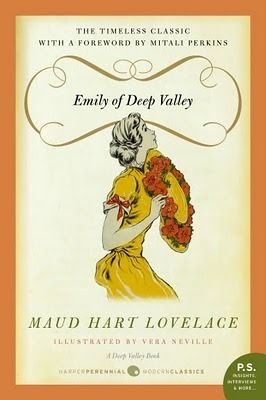
 Come visit me on the Fire Escape!
Come visit me on the Fire Escape!




One Saturday morning when we were new to America, my sister and I walked to the Flushing Public Library, two miles from our apartment. It was my first visit to a library. I wandered through the stacks wide-eyed, fingering spines of unread books like a beggar in a bakery. I could take seven of them home with me! I chose carefully, knowing I'd savor them later on the fire escape, my secret reading sanctuary.So please, please, please, don't hesitate to introduce EMILY to young readers everywhere. Or do yourself a favor and get a copy for you. It's also the release day for CARNEY'S HOUSE PARTY AND WINONA'S PONY CART , with a delightful, inspiring new foreword written by Melissa Wiley . Happy Book Birthday, Maud Hart Lovelace!
It didn't take long to find Maud Hart Lovelace's concoctions. Her classic novels served as a superb orientation for a newcomer eager to understand the history and heritage of a new world. They took me back to the early 1900s, a time when America shared many of the values that resonated in my old-world home, but they also sparkled with timeless humor that made me laugh out loud on the fire escape.

 Come visit me on the Fire Escape!
Come visit me on the Fire Escape!



Published on October 12, 2010 17:48
October 7, 2010
You're Invited! A Cuci Mata Read of Classic Children's Books
 I recently
learned
from Karen Lotz, publisher of Candlewick, that the Indonesian phrase Cuci Mata means a "washing of the eyes." Aha! I thought. The perfect metaphor for my new feature on Mitali's Fire Escape.
I recently
learned
from Karen Lotz, publisher of Candlewick, that the Indonesian phrase Cuci Mata means a "washing of the eyes." Aha! I thought. The perfect metaphor for my new feature on Mitali's Fire Escape.While we may not want to bowdlerize the classics of the past, we are eager to grow in our ability to discern both anachronistic and universal attitudes in stories (even, and perhaps especially, in our own). Every month, we'll choose a novel written by a now-dead—no hurt feelings that way—children's book author and explore attitudes towards race, class, gender, and culture as revealed in that story. What stands the test of time in this novel?
Our goal is not to critique and condemn these beloved authors with arrogant "we-know-better-than-you" twenty-first century eyes. We will wash our eyes, see in a fresh way, and find elements in these stories to celebrate as universally relevant. But we also want to notice what the authors themselves might have wished they could change for today's young readers.
I invite you to join me the first week of each month, either here on the Fire Escape, where I'll be blogging my thoughts about the books and asking questions, or via Twitter using the hashtag #kidclassic. I'm trying to pick lesser-known novels written by famous authors. Here's what I've scheduled so far:
November 1-5 Emily of Deep Valley by Maud Hart Lovelace
(Full disclosure: I wrote the foreword to the re-issue of this novel from HarperPerennial as a labor of love, but don't let that stop you from seeing it with fresh eyes and speaking to us about what you see.)
December 1-7 An Old Fashioned Girl by Louisa May Alcott
January 3-7 The Well-Wishers by Edward Eager
Other suggestions?
If you're going to join us, please leave a note in the comments. Thanks so much!
Photo courtesy of ryawesome via Creative CommonsCome visit me on the Fire Escape!




Published on October 07, 2010 12:27
October 5, 2010
Culture, Justice, and Kid/YA Books: A Chat between Olugbemisola Rhuday-Perkovich, Mitali Perkins, and Susanna Reich
[image error] During the 2010 Brooklyn Book Festival , Susanna Reich moderated a conversation in the PEN American booth between Olugbemisola Rhuday-Perkovich (8th GRADE SUPERZERO) and me. We chatted about writing characters who are social misfits, how writing biographies is similar to writing across cultures, raising questions of faith in fiction, writing to learn, and ... zombies along the Thai-Burma border? But wow, I don't remember talking quite so much ...
Download the mp3Come visit me on the Fire Escape!




Published on October 05, 2010 07:21
October 4, 2010
Selling Color in a White World: Notes From NEIBA
 "Look around the room," said bookseller Elizabeth Bluemle (pictured left), introducing our New England Independent Booksellers Association panel,
Selling Color in a White World
. "Our industry is still dominated by white people, and honestly, we get lazy handselling books featuring people of color."
"Look around the room," said bookseller Elizabeth Bluemle (pictured left), introducing our New England Independent Booksellers Association panel,
Selling Color in a White World
. "Our industry is still dominated by white people, and honestly, we get lazy handselling books featuring people of color."After she introduced the panelists, I kicked things off with my usual windows and mirrors spiel and gave two examples of how indies can make a huge difference: my visits to Titcomb's Bookstore in Sandwich, Ma and Aaron's Bookstore in Lititz, PA.

Karen Lotz, Elizabeth Bluemle, and I
Next came Karen Lotz, President and Publisher of Candlewick. "We feel relatively free from the pressure of gatekeepers," she said. "We're a creatively-led house."
She shared a story about Kareen Abdul Jabbar, who asked to meet with her at a recent BEA. The legendary basketball player came with one request: please package books for and about black kids with the same bling as books for the mainstream. Candlewick makes it a point to comply.
 Elizabeth raised the elephant-in-the-room question: do covers featuring people of color hinder sales in mostly-white communities?
Elizabeth raised the elephant-in-the-room question: do covers featuring people of color hinder sales in mostly-white communities?When it comes to cover decisions, Candlewick goes through a collaborative cycle that provides input to designers who have read the book mindfully and thoroughly. Karen proudly held up a new Candlewick book, Zora and Me by Victoria Bond and T.R. Simon, making the case that the gorgeous face of a young Zora Neale Hurston on the cover was absolutely necessary for sales.
Karen concluded by encouraging us with the Indonesian concept of Cuci Mata, which literally means a washing of the eyes, something we all need so that we can begin to see in a fresh way.
Stacy L. Whitman, editorial director of Tu Books , a new multicultural Sci-Fi/Fantasy imprint of Lee and Low, joined the panel by phone after a flooded New York train station hindered her travel. Stacy gave us the background of how and why she launched the imprint, starting with race fail and ending with plans for the six YA titles she's excited to launch each year.
Elizabeth summed things up with a fantastic presentation targeted for indies on how and why to handsell books featuring nonwhite protagonists. She'll share it on her Publishers Weekly blog , but some of her tips included letting sales reps know of an interest in multicultural books, avoiding the segregation of titles in the store, and booktalking by making connections unrelated to race. (Note: we talked about the problem with labels like "people of color," "nonwhite," and "multicultural.")
I added two of my favorite suggestions for bookstores and libraries alike: (1) invite a friend or patron who isn't white to peruse your displays and give you feedback and (2) avoid the danger of a single story , a phrase coined by novelist Chimamanda Adichie.
We didn't leave much time for Q and A, but booksellers shared a few tips and stories from their own experiences. It was a good session, one that I've long anticipated, and a prototype of conversations I hope will be repeated in diverse places with diverse participants.Come visit me on the Fire Escape!




Published on October 04, 2010 12:50
September 30, 2010
A Chat With Jessica Leader, Author of NICE AND MEAN
I've been
challenging
my author friends—and myself—to take risks in crossing borders of class and race in fiction, but to do it wisely and carefully, respecting the inherent power of storytelling. It's lovely to find an example or two to showcase, like
NICE AND MEAN
, one of my favorite middle-school reads of 2010.
 Sparkling with creativity and humor, this tween novel features two protagonists, Marina ("Mean") and Sachi ("Nice"), who is Indian-American. A pet peeve of mine is the insertion of a nonwhite character into a story whose sole purpose is to serve as a sinless foil for a main white character. Sachi, in contrast, is a flawed but sympathetic middle-schooler. Author Jessica Leader gives her a first-person voice that's funny and true, and pays attention to cultural details as she invites us into Sachi's home. I asked Jessica to chat with us on the Fire Escape, so sit back, relax, and enjoy the conversation.
Sparkling with creativity and humor, this tween novel features two protagonists, Marina ("Mean") and Sachi ("Nice"), who is Indian-American. A pet peeve of mine is the insertion of a nonwhite character into a story whose sole purpose is to serve as a sinless foil for a main white character. Sachi, in contrast, is a flawed but sympathetic middle-schooler. Author Jessica Leader gives her a first-person voice that's funny and true, and pays attention to cultural details as she invites us into Sachi's home. I asked Jessica to chat with us on the Fire Escape, so sit back, relax, and enjoy the conversation.
Briefly describe Jessica in middle school. Were you more like Sachi or Marina?
I must admit that there are times when I feel like I am still in middle school. As for the official 5th-8th-grade years, I would say I had elements of both Sachi and Marina. Like Sachi, I often felt completely different from the so-called popular kids. What was the coolness they saw in each other? Why did they all have such good hair? Like Marina, I sometimes felt frustrated with what I saw as my friends' shortcomings and I may have tried to let them know it, just occasionally. Never with a nasty video, though!
One scene in the book made me squirm with old memories. I would have been *mortified* and *mad* (like Sachi was) if one of my born-in-the-USA classmates had come over while we were eating dinner as a family and my parents and I had to eat with our hands in front of her. Did you have good friends who were Indian? What kind of cross-cultural "research" did it take to write Sachi's character and family?
 I'm glad that scene resonated, because I did a lot of research to make the Sachi-at-Home scenes ring true. At first, I read books and articles and eavesdropped on my Indian-American students. As the publication date got closer, I realized I needed more thorough verification and made connections with acquaintances who were willing to read the manuscript. They were very insightful about what rang true and what didn't, and I'm still grateful for their help.
I'm glad that scene resonated, because I did a lot of research to make the Sachi-at-Home scenes ring true. At first, I read books and articles and eavesdropped on my Indian-American students. As the publication date got closer, I realized I needed more thorough verification and made connections with acquaintances who were willing to read the manuscript. They were very insightful about what rang true and what didn't, and I'm still grateful for their help.
It's funny that you mention the eating part. I actually didn't know until late in the process that some Indian families ate with their hands, but I revised to put that in, because it opened up so many possibilities for deep emotion. I could just imagine how tough that would be for Sachi to do that with Marina looking on—on one hand, not wanting to feel ashamed for being different; on the other, knowing that Marina is not exactly the poster-child for cross-cultural understanding.
Your book made me want to take a class on making film! Have you ever made a video like the one you described?
Wow, you spotted my research topics a mile away! You must be some kind of writer or something.
Sachi and Marina are way more experienced at video-making than I am. I don't think I've even used editing software! But I do have two friends who have taught video to middle-schoolers, and they helped me out with the details. One did so indirectly—I snooped around his classroom—and another read the video portions of the novel and corrected my errors. That included, "Jess, you keep saying that things are 'offstage,' but I think you mean, 'offscreen.'" I wrote plays before I wrote novels, so I guess I had defaulted to theatre jargon.
What was one big change you made in response to your editor's suggestion?
What kicks the action for Sachi is that she wants so badly to take Video Elective that she goes behind her parents' backs. In my earlier drafts, Sachi didn't have any big plans for her video; she was going to wait until she got a partner to decide together. (This stands in stark contrast to her partner Marina, who begins the first class with a plot, a title, and props.)
My editor pointed out that Sachi should know what she wants to say with her video. After all, she's willing to lie to her parents, so she must have some specific goals. I figured out that Sachi would want to do something like last year's video winners did—a video that challenged her classmates to think about the racial divisions in her school. When I realized this about her, it gave me more momentum for her character, and more of a chance for readers to say, "Holy Bleep!" when Marina comes along with her plan to spoof a fashion TV show.
Let's move on to the journey of getting the novel published. What was a high point? A low point?
Low point: no specific point that I can think of; just the years of rejection, wondering if I'd ever know how to make it all work and who would point me out of the woods.
The high point, aside from learning that the book was going to be published, was learning that it would appear on the Summer IndieNext List, which is how independent bookstores recommend books to each other and their customers. I'd done so much work to self-publicize, and here was a bit of publicity that seemed to have legs of its own. Plus, I love indie bookstores, so it was a thrill to get their endorsement.
What's next for Jessica in the world of Kid/YA books?
You can read excerpts of what I hope will be my next middle-grade novel, NOT THAT GIRL, in the Louisville Courier-Journal's Sunday serial series, published this past August. So Dickenzian, no? However, readers will be relieved to note that I am not being paid by the word. The story, about an eighth-grader whose life starts to crumble when she gets her first boyfriend, is, I hope, as zippy as NICE AND MEAN.
Thanks so much, Jessica, for spending time on the Fire Escape. So glad you're taking risks in writing fiction for tweens! Looking forward to NOT THAT GIRL. (Note: A former teacher, Jessica's available for author visits, including Skype visits. Contact her for more information.)Come visit me on the Fire Escape!




 Sparkling with creativity and humor, this tween novel features two protagonists, Marina ("Mean") and Sachi ("Nice"), who is Indian-American. A pet peeve of mine is the insertion of a nonwhite character into a story whose sole purpose is to serve as a sinless foil for a main white character. Sachi, in contrast, is a flawed but sympathetic middle-schooler. Author Jessica Leader gives her a first-person voice that's funny and true, and pays attention to cultural details as she invites us into Sachi's home. I asked Jessica to chat with us on the Fire Escape, so sit back, relax, and enjoy the conversation.
Sparkling with creativity and humor, this tween novel features two protagonists, Marina ("Mean") and Sachi ("Nice"), who is Indian-American. A pet peeve of mine is the insertion of a nonwhite character into a story whose sole purpose is to serve as a sinless foil for a main white character. Sachi, in contrast, is a flawed but sympathetic middle-schooler. Author Jessica Leader gives her a first-person voice that's funny and true, and pays attention to cultural details as she invites us into Sachi's home. I asked Jessica to chat with us on the Fire Escape, so sit back, relax, and enjoy the conversation.Briefly describe Jessica in middle school. Were you more like Sachi or Marina?
I must admit that there are times when I feel like I am still in middle school. As for the official 5th-8th-grade years, I would say I had elements of both Sachi and Marina. Like Sachi, I often felt completely different from the so-called popular kids. What was the coolness they saw in each other? Why did they all have such good hair? Like Marina, I sometimes felt frustrated with what I saw as my friends' shortcomings and I may have tried to let them know it, just occasionally. Never with a nasty video, though!
One scene in the book made me squirm with old memories. I would have been *mortified* and *mad* (like Sachi was) if one of my born-in-the-USA classmates had come over while we were eating dinner as a family and my parents and I had to eat with our hands in front of her. Did you have good friends who were Indian? What kind of cross-cultural "research" did it take to write Sachi's character and family?
 I'm glad that scene resonated, because I did a lot of research to make the Sachi-at-Home scenes ring true. At first, I read books and articles and eavesdropped on my Indian-American students. As the publication date got closer, I realized I needed more thorough verification and made connections with acquaintances who were willing to read the manuscript. They were very insightful about what rang true and what didn't, and I'm still grateful for their help.
I'm glad that scene resonated, because I did a lot of research to make the Sachi-at-Home scenes ring true. At first, I read books and articles and eavesdropped on my Indian-American students. As the publication date got closer, I realized I needed more thorough verification and made connections with acquaintances who were willing to read the manuscript. They were very insightful about what rang true and what didn't, and I'm still grateful for their help. It's funny that you mention the eating part. I actually didn't know until late in the process that some Indian families ate with their hands, but I revised to put that in, because it opened up so many possibilities for deep emotion. I could just imagine how tough that would be for Sachi to do that with Marina looking on—on one hand, not wanting to feel ashamed for being different; on the other, knowing that Marina is not exactly the poster-child for cross-cultural understanding.
Your book made me want to take a class on making film! Have you ever made a video like the one you described?
Wow, you spotted my research topics a mile away! You must be some kind of writer or something.
Sachi and Marina are way more experienced at video-making than I am. I don't think I've even used editing software! But I do have two friends who have taught video to middle-schoolers, and they helped me out with the details. One did so indirectly—I snooped around his classroom—and another read the video portions of the novel and corrected my errors. That included, "Jess, you keep saying that things are 'offstage,' but I think you mean, 'offscreen.'" I wrote plays before I wrote novels, so I guess I had defaulted to theatre jargon.
What was one big change you made in response to your editor's suggestion?
What kicks the action for Sachi is that she wants so badly to take Video Elective that she goes behind her parents' backs. In my earlier drafts, Sachi didn't have any big plans for her video; she was going to wait until she got a partner to decide together. (This stands in stark contrast to her partner Marina, who begins the first class with a plot, a title, and props.)
My editor pointed out that Sachi should know what she wants to say with her video. After all, she's willing to lie to her parents, so she must have some specific goals. I figured out that Sachi would want to do something like last year's video winners did—a video that challenged her classmates to think about the racial divisions in her school. When I realized this about her, it gave me more momentum for her character, and more of a chance for readers to say, "Holy Bleep!" when Marina comes along with her plan to spoof a fashion TV show.
Let's move on to the journey of getting the novel published. What was a high point? A low point?
Low point: no specific point that I can think of; just the years of rejection, wondering if I'd ever know how to make it all work and who would point me out of the woods.
The high point, aside from learning that the book was going to be published, was learning that it would appear on the Summer IndieNext List, which is how independent bookstores recommend books to each other and their customers. I'd done so much work to self-publicize, and here was a bit of publicity that seemed to have legs of its own. Plus, I love indie bookstores, so it was a thrill to get their endorsement.
What's next for Jessica in the world of Kid/YA books?
You can read excerpts of what I hope will be my next middle-grade novel, NOT THAT GIRL, in the Louisville Courier-Journal's Sunday serial series, published this past August. So Dickenzian, no? However, readers will be relieved to note that I am not being paid by the word. The story, about an eighth-grader whose life starts to crumble when she gets her first boyfriend, is, I hope, as zippy as NICE AND MEAN.
Thanks so much, Jessica, for spending time on the Fire Escape. So glad you're taking risks in writing fiction for tweens! Looking forward to NOT THAT GIRL. (Note: A former teacher, Jessica's available for author visits, including Skype visits. Contact her for more information.)Come visit me on the Fire Escape!




Published on September 30, 2010 12:21























